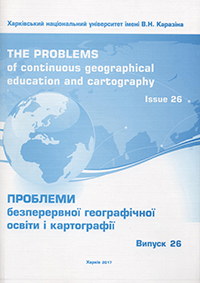Study of the labor market and population employment in the school course of socio-economic geography
Abstract
The article examines the peculiarities of studying the labor market and employment of the population in the course «Economic and social geography» in general education institutions. Differences in the approaches to the interpretation of the concepts content, the volume and submission of material are shown, shortcomings in the text of manuals of different authors are revealed. The analysis of the textbooks on economic and social geography used in the general educational institutions of Moldova, Russia, Ukraine shows that the fundamental elements of the labor market are not studied at the proper level (or absent as a subject of study), not only in the sections on the geography of the population, but even in sections reflecting the geography of the economy. Textbooks on economic and social geography for general educational institutions contain incomplete, fragmentary, non-systematic, and often inaccurate information about the labor market and employment of the population. The links with the demographic situation, features and prospects for the development of economic systems of individual countries and their regions are not sufficiently reflected. Many textbooks do not provide specific data characterizing the labor market and employment of the country’s population, its large territorial units, economic and administrative areas. We consider it advisable to supplement the content of textbooks with the necessary logically and systematically constructed information on labor resources, using clearly defined concepts: «labor resources», «able-bodied population», «able-bodied age», «labor market», «unemployment» and its forms, «employment structure», «employment level», «economically active population», «economically inactive population», «employed population», «labor balance». The author offers her own version of the concepts study, indicators of the labor market and employment of the population. Important indicators that characterize the labor market of individual countries include: a) the proportion of persons engaged in material production; b) the proportion of persons engaged in material production to the total population; c) the general coefficient of demographic burden, reflecting the number of dependents per employed person; d) the load factor of pensioners, reflecting the number of pensioners per 1.000 employees; e) the level of national labor productivity.
Downloads
References
2. Bahchieva, O.A. (2013). Geografija. Jekonomicheskaja i social’naja geografija mira: 10-11 kl. [Economic and social geography of the world: 10-11 forms]. Moskva: Ventana-Graf, 400.
3. Alekseev, A.I., etc., ed. (2014). Geografija. Rossija. 8 kl.: Ucheb. dlja obshheobrazovat. organizacij [Geography. Russia. 8th form: Textbook for general education organizations]. Moskva: Prosveshhenie, 255.
4. Alekseev, A.I., ed. (2014). Geografija. Rossija. 9 kl.: Ucheb. dlja obshheobrazovat. organizacij [Geography. Russia. 9th form: Textbook for general education organizations]. Moskva: Prosveshhenie, 240.
5. Domogackih, E.M. (2013). Geografija: Naselenie i hozjajstvo Rossii: Ucheb. dlja 9 kl. obshheobrazovat. uchrezhdenij [Geography: Population and economy of Russia: Textbook for the 9th form of general education institutions]. Moskva: OOO «Russkoe slovo – uchebnik», 280.
8. Dronov, V.P., Rom, V.Ja. (2001). Geografija Rossii. Naselenie i hozjajstvo. 9 kl.: Ucheb. dlja obshheobrazovat. zavedenij [Geography of Russia. Population and economy. 9th form: Textbook for general educational institutions]. Moskva: Drofa, 384.
7. Maksakovskij, V.P. (2001). Jekonomicheskaja i social’naja geografija mira: Ucheb. dlja 10 kl. obshheobrazovat. uchrezhdenij [Economic and social geography of the world: Textbook for the 10th form of general education institutions]. Moskva: Prosveshchenie, 350.
8. Sy`rotenko, A.J. (2001). Ekonomichna i soczial`na geografy`ya Ukrainy` [Economic and social geography of Ukraine]. Ky`yiv: Osvita, 222.
9. Holina, V.N. (2013). Geografija. 10 kl. Uglublennyj uroven’: Ucheb. [Geography: 10th form. Advanced level: Textbook]. Moskva: Drofa, 319.
10. Chubarje, S.A. (1997). Obshhaja jekonomicheskaja i social’naja geografija: Ucheb. dlja 8 kl. [General economic and social geography: Textbook for the 8 form]. Kishinev: TIPCIM, 208.





